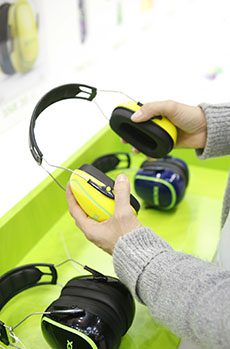
Even a low level of noise can be hazardous to the human ear and may have serious consequences such as loss of hearing. Earplugs and other devices can prevent this from happening, and there are now apps to measure the noise level and obtain recommendations on appropriate hearing protection. The complete range of innovations in hearing protection on the PPE market will be available to view at A+A 2017, a trade fair and convention on occupational health and safety being held in Düsseldorf from 17 to 20 October 2017. This article offers a preview and a glimpse of current trends in the hearing protection arena.
Let’s start with the good news: “When it comes to the damage that a person can suffer from a noisy workplace, there has been an increasing awareness recently,” says Manfred Schuster, head of Hearing Protection at Uvex, one of around 1,900 exhibitors at A+A 2017. To reduce potential hazards, the safety engineers of companies are in close contact with manufacturers. This is confirmed by Joao Rosario, application engineer with the multi-technology group 3M. Rosario believes that this is important because “although medicine has made amazing progress in the treatment of hearing damage in recent years, it’s impossible to eliminate all hearing problems.” Preventative healthcare therefore continues to be vital, and so does the use of personal protection equipment (PPE).
A regulation with an important bearing on this matter, which is attracting attention at present, is the new European PPE Regulation 2016/425. It has been in force since April 2016 and puts hazardous noise in Category III, i.e. “risks that may cause very serious consequences such as death or irreversible damage to health”. Manufacturers must therefore have their ear protection products checked for conformity at annual intervals, whereas, until recently, it was sufficient to have a renewed inspection five years after receiving an EU type examination certificate.
Different noisy environments
One major practical challenge is considered to be the variety of noise levels in the working environment. “As working conditions change,” says Joao Rosario from 3M, “it becomes more and more important to use hearing protection which is suitable for a variety of noisy environments.” The technology group has developed earplugs where users can toggle between a higher and lower level of protection, while also being protected against impulse noise – i.e. short sudden burst of noise – at both levels.
Although efforts are continually in progress to reduce machine noise, some industrial work is still extremely noisy, e.g. demolition jobs and any work that involves metalworking and woodworking equipment. But even the “pleasant noise” of a band or orchestra can have a detrimental effect on the listener’s health. The most reasonably priced way to protect oneself is to use a pair of simple foam earplugs, made, for instance, by manufacturers like Honeywell, Uvex and 3M – all of them scheduled to exhibit at A+A. Yet although this form of PPE protects the wearer against the damaging power of noise, created by air pressure in the ear, the noise is still perceived in a distorted form.
One alternative to ready-to-use earplugs is ear moulds that can be individually adjusted. They are made, for instance, by Elacin Hearing Protection from the Netherlands, another company at A+A. With this form of hearing protection the emphasis is on both speech intelligibility and high wearing comfort. This kind of specially customised hearing protection can now be made in a 3D printing process at an accuracy of down to a millimetre. Nevertheless, the devices still need to be checked, both at delivery and then at regular intervals, to make sure they maintain their protective function and also to prevent any pressure that might result from frequent head movements.
Smart hearing protection
A hearing protection product that is currently gaining in popularity is one that can be used, for instance, in conjunction with a smartphone, when listening to music or making phone calls. For certain professional groups, such as wind turbine mechanics and forestry workers, it is important to stay in touch with colleagues across distances. This, too, can be ensured through active hearing protection.
Another area which is receiving more and more attention is earplugs, earmuffs and hearing aids with miniature batteries. They can deliver, for instance, level-dependent attenuation while also amplifying very low noises – a useful feature for military purposes. Such a smart hearing protection and communication system is offered, for instance, by Honeywell, a leading supplier of protective clothing. Honeywell will also be presenting its product range of protective clothing and contamination protection at A+A 2017. In all, over 120 hearing protection suppliers are set to showcase their latest trends and innovations at the world’s leading Düsseldorf trade fair on personal protection, corporate safety and a healthy workplace.
The more complex and expensive the hearing protection, the more there is a demand for accessories. “Hygiene sets, for instance, play a major role – both in passive and active earmuffs,” says Joao Rosario. “Active hearing protection involves accessories such as wind protection for microphones, rechargeable batteries and rechargers.” All accessories are of a high quality, offering increasingly smart solutions. “Electronic hearing protection,” says Manfred Schuster, “can now be provided with packaging that has integrated rechargers.”
Apart from functionality, training is another important factor in hearing protection. The right kind of protection can be identified, and information can be obtained on the appropriate use of equipment. Uvex puts up small stands in its customers’ canteens, where it then provides information on this subject which tends to be underestimated in its significance. As well as obtaining advice and training on their own premises, safety engineers can also receive CPD at the Uvex Academy or at 3M, where suitable courses are run for professionals.
Using an app to measure noise
The two A+A exhibitors 3M and Uvex each have a decibel app where users can find out on their smartphones whether they ought to wear hearing protection. Appropriate noise protection options are then presented in the form of a colour scale. Green means that no protection is needed, yellow that it is mandatory, and red that protection must be specially adjusted to suit high- or medium-frequency noise. Next, the app recommends suitable products. It is also a simple way to sharpen one’s sensitivity to noise and to assess the potential hazards correctly.
Up-to-date details of A+A 2017 and its exhibitors, e.g. hearing protection suppliers, are available at www.aplusa.de.







